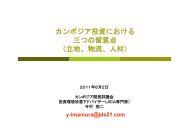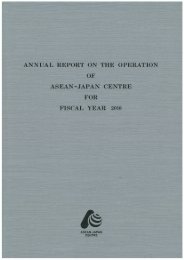2 Alcoholic Beverages (Beer, Wine, Whisky, etc.) - ASEAN-Japan ...
2 Alcoholic Beverages (Beer, Wine, Whisky, etc.) - ASEAN-Japan ...
2 Alcoholic Beverages (Beer, Wine, Whisky, etc.) - ASEAN-Japan ...
Create successful ePaper yourself
Turn your PDF publications into a flip-book with our unique Google optimized e-Paper software.
C-2. <strong>Alcoholic</strong> <strong>Beverages</strong> (<strong>Beer</strong>, wine, whisky, <strong>etc</strong>.)<br />
has decreased 6.5% over the past 5 years, with consumption per adult decreasing 8.3%.<br />
Causes for the downward trend in the market in recent years include change in lifestyle, the economic<br />
depression over the past several years, notably reduction of prices, lite-conscious trend, and diversification of<br />
tastes. The number of young people who do not drink alcoholic beverages at all, or only drink low-alcoholic<br />
beverages, has increased.<br />
Among alcoholic beverages, beer is most favored by the <strong>Japan</strong>ese, occupying 38.2% of the total annual<br />
alcohol production amount. However, after the sale of happoshu began in 1994, the production amount and<br />
total share of beer has continued to decrease with a 7.9% decrease in 2005 over the previous year. Furthermore,<br />
sparkling malt beverage, so-called happoshu which increased production amount at the expense of beer, has<br />
fallen into the negative area since the tax increase of happoshu in May 2005, and has decreased immensely<br />
since that time, with a 25% decrease over the previous year. Instead, “beer-tasting drinks of the third<br />
generation” (the so-called third beer that statistically corresponds to a hybrid), which do not use malt or oats,<br />
have replaced the consumption amount of happoshu. Following the big hit of “Draft-One" by Sapporo <strong>Beer</strong>,<br />
Suntory, Kirin <strong>Beer</strong>, and Asahi <strong>Beer</strong> also entered into the third beer market, and in 2004, the production amount<br />
greatly expanded to 16 times that of the previous year, then 3.6 times in 2005.<br />
Liqueurs and spirits also steadily increased, since they are necessary to make cocktails, which are popular<br />
among women and shochu-based canned beverage. Shochu (distilled spirits)-based beverages are original to<br />
<strong>Japan</strong> where fruit flavored soda water, such as lemon, grapefruit, or orange, is added to a distilled alcoholic<br />
base such as shochu, neutral spirits (raw material alcohol), or vodka. These beverages are sold at a low-price<br />
(approximately 120-150 yen for a 350ml can), and have a low-alcohol content (about 5-7% alcohol). For<br />
example, Kirin began sale of “Hyoketsu” in 2001, which soon became popular among young people and<br />
women, and other companies soon followed. Each company seeks to differentiate itself from its competitors<br />
in one way or another in order to increase its market share by adding low-calorie products in response to health<br />
trends or seasonal products.<br />
For several years, a downward trend in the consumption volume of wine (fruit wine) could be seen, but in<br />
2005, a positive increase of 2.2% over the previous year was experienced, due in part by a boom in sparkling<br />
wines, including champagne.<br />
The peak of the shochu boom also seems to have passed, but sales are still steady (0.0% increase over the<br />
previous year), and the market is led by popular large-volume bottles in A Class that focus on low-price<br />
products, and potato shochu and Awamori in B Class.<br />
Fig. 1 <strong>Japan</strong>ese consumption of alcoholic beverages (2005)<br />
Total annual<br />
consumption<br />
(kl)<br />
Percentag<br />
e of total<br />
Per capita<br />
consumption<br />
(ml)<br />
Yearly<br />
change<br />
<strong>Beer</strong> 3,606,826 38.2 34,805 92.1<br />
Happoshu 1,782,154 18.9 17,197 75.0<br />
Miscellaneous<br />
liquor<br />
887,349 9.4 8,563 361.4<br />
<strong>Japan</strong>ese sake 737,676 7.8 7,118 96.7<br />
<strong>Japan</strong>ese<br />
shochu<br />
1,047,193 11.1 10,105 100.0<br />
Liqueur 778,244 8.2 7,510 109.7<br />
Spirits 78,289 0.8 755 99.0<br />
Fruit wine 259,683 2.7 2,506 102.2<br />
<strong>Whisky</strong> 95,234 1,0 919 95.9<br />
Others 174,454 1.9 1,684 ――<br />
TOTAL 9,447,102 100.0 91,162 97.8<br />
Marketing Guide for <strong>ASEAN</strong> Exporters to <strong>Japan</strong><br />
186<br />
On the other hand, the consumption amount of<br />
high-alcohol content whisky and sake has decreased,<br />
influenced by the trend for low-alcohol, with a 4.1%<br />
and 3.3% decrease, respectively, over the previous year.<br />
However, the industry assumes that the downward<br />
trend over the past several years has eased due to<br />
single malt whisky gaining popularity and the boom in<br />
<strong>Japan</strong>ese sake, especially with women.<br />
In contrast to the trend towards low-price, the number<br />
of people who still demand genuine quality, even at a<br />
higher price, has also increased, not just for single malt<br />
whisky as mentioned above, but also for premium beer<br />
and premium shochu products, with a steady expansion<br />
of the support base. As a result, a polarization of the<br />
market has developed.<br />
Source: Bureau of Statistics, Ministry of Internal Affairs and Communications.<br />
Note) Production amount of alcohol is based on the taxable amount, according to the Tax Administration Agency (total amount of products<br />
produced in <strong>Japan</strong> or imported).<br />
Consumption volume per person is calculated based on the adult population.




